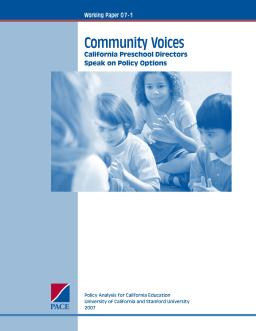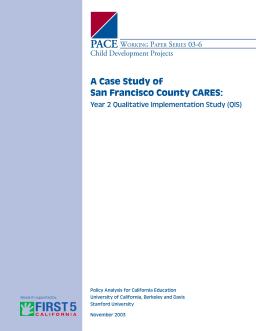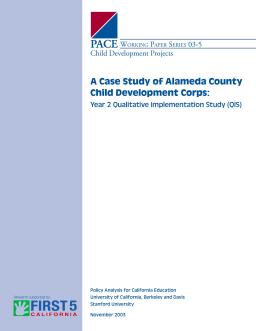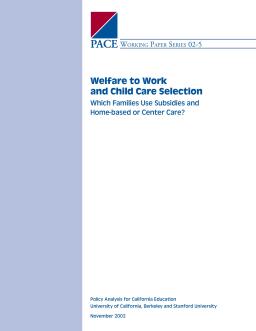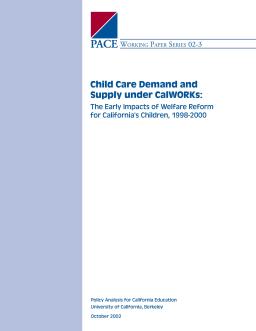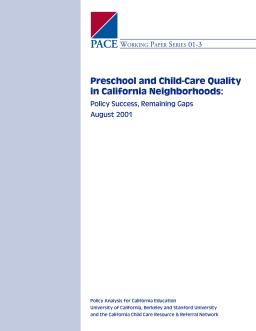Preschool and K–12 Finance Reform in New Jersey and Texas
Published
Summary
This report examines factors that affect student achievement in California schools, finding that family background and school context are important determinants. The report recommends that schools focus on providing high-quality instruction, improving reading and math skills, and creating a positive school climate. Policymakers should increase resources for under-resourced schools and promote parental involvement. Continued research is needed to better understand the complex factors that shape student outcomes.
California Preschool Directors Speak on Policy Options
Published
Summary
This report discusses the potential of integrating academic and occupational content through Career-Technical Education (CTE)/multiple pathways to improve California's high schools. This approach can enhance student motivation and engagement in school, improve employment and earnings after graduation, and provide more opportunities for students. They suggest building on existing practices in career academies, restructured high schools, and community colleges, but note that additional funding, technical assistance, and professional development will be necessary to support this approach.
The Influence of Preschool Centers on Children’s Social and Cognitive Development
Published
Summary
Using national data from the Early Childhood Longitudinal Study (ECLS-K), this study examines the association between center-based care duration and intensity and pre-reading, math skills, and social behavior of young children. Children who start center care between ages two and three see greater academic gains, while starting earlier than age two may have negative social effects. Center intensity impacts academic gains for poor and middle-income children, but not wealthier children, and negatively impacts social development for Blacks and whites but not Hispanic children.
Ideals, Evidence, and Policy Options
Published
Summary
Many California children benefit from preschooling, but enrollment rates are lower for poor and working-class families. Quality is uneven, and policy makers must address key questions regarding expanding and improving preschooling, including who should benefit and who should pay, who should operate it, how to improve quality, and how to structure it for diverse families. Evidence can inform policy options, which stem from differing ideals about preschooling. Nationwide evidence is considered in this review.
Year 2 Qualitative Implementation Study (QIS)
Published
Summary
This paper assesses the perspectives and experiences of stakeholders on San Francisco County’s CARES program, a childcare retention–incentive program. Year 2 saw over a threefold increase in the number of stipends awarded, but recipients felt the program couldn't address ECE staff retention/turnover alone. Solutions need to be implemented within a larger system of support, raising public awareness, expanding professional development opportunities, and exerting pressure on policymakers for sustained funding to augment ECE staff salaries.
Year 2 Qualitative Implementation Study (QIS)
Published
Summary
This paper discusses the second year of Alameda County’s Child Development Corps program as a childcare retention-incentive program. The program's goals were to encourage staff training, professional development, and establish a strong network of ECE professionals. Stipend recipients were pleased with the program but recognized that it could not function alone in addressing staff retention, and a larger system of support and advocacy was necessary.
Which Families to Serve First? Who Will Respond?
Published
Summary
This paper discusses extending access to preschool for families in California, focusing on targeting priorities to yield strong enrollment demand and discernible effects on young children's early development and school readiness. It analyzes different targeting mechanisms and suggests experimenting with alternative expansion strategies, rather than investing exclusively in one method. The report also describes which communities would benefit most and considers the criteria for judging the wisdom of targeting options.
Which Families Use Subsidies and Home-Based or Center Care?
Published
Summary
Public spending on childcare has increased, but low-income families still face barriers to accessing subsidies. This working paper examines the choices made by 1,974 parents in California who moved from welfare to work and needed childcare. The study found that parents relied on a mix of formal and informal childcare options, and that the expansion of one form of care did not necessarily influence parents' choices.
The Early Impacts of Welfare Reform for California's Children, 1998–2000
Published
Summary
This report examines the effects of welfare-to-work and childcare capacity building on the childcare system in California, prompted by changes in the childcare system and welfare reform. The study was requested by the California Department of Social Services, and this paper provides an overview of the findings.
Descriptive Findings from the Child Care Subsidy Interview
Published
Summary
CDSS and PACE conducted a survey of CalWORKs participants in Kern, Orange, and Santa Clara counties, interviewing 1,974 individuals in three languages. This report presents demographic data and survey responses, including frequencies and select responses by county, language, and ethnic groups.
Findings from the Child Care Providers Focus Groups
Published
Summary
This report presents findings from PACE's study on how California's childcare subsidy system and CalWORKs program impact licensed and license-exempt childcare providers. Five focus groups were conducted in 1999 and 2000, with topics organized by providers' services, philosophies of care, operational issues, and opinions about the subsidy system. The report provides insight into the experiences of childcare providers across California, but does not claim to be representative of the industry.
Published
Summary
This report discusses an initiative by the California Children and Families Commission to expand the availability and quality of early care and education programs. The project includes recruiting and training early care providers, improving professional preparation, and implementing strategies to retain trained providers. The report provides information on existing training programs available to early childhood professionals and students, including accredited/non-accredited opportunities at community colleges, state universities, private colleges, and child care resource and referral agencies.
Policy Success, Remaining Gaps
Published
Summary
This paper analyzes the quality of center-based programs in diverse lower-income communities in California. The majority of centers displayed high levels of quality, and community conditions such as poverty levels and ethnic composition did not consistently influence quality. Public subsidies positively affected center quality, while the presence of more programs in a community may slightly lower quality due to increased demand for enrollment.
Focusing on San Francisco and Santa Clara Counties
Published
Summary
This report analyzes California's early childhood education programs and finds that attending public preschool programs improves school readiness and academic performance, particularly for low-income children. The study also shows that the economic benefits of preschool programs far outweigh the costs, including increased earnings and decreased need for remedial education and social services. Recommendations include expanding access to high-quality preschool programs for low-income children in California to reduce economic inequality.

